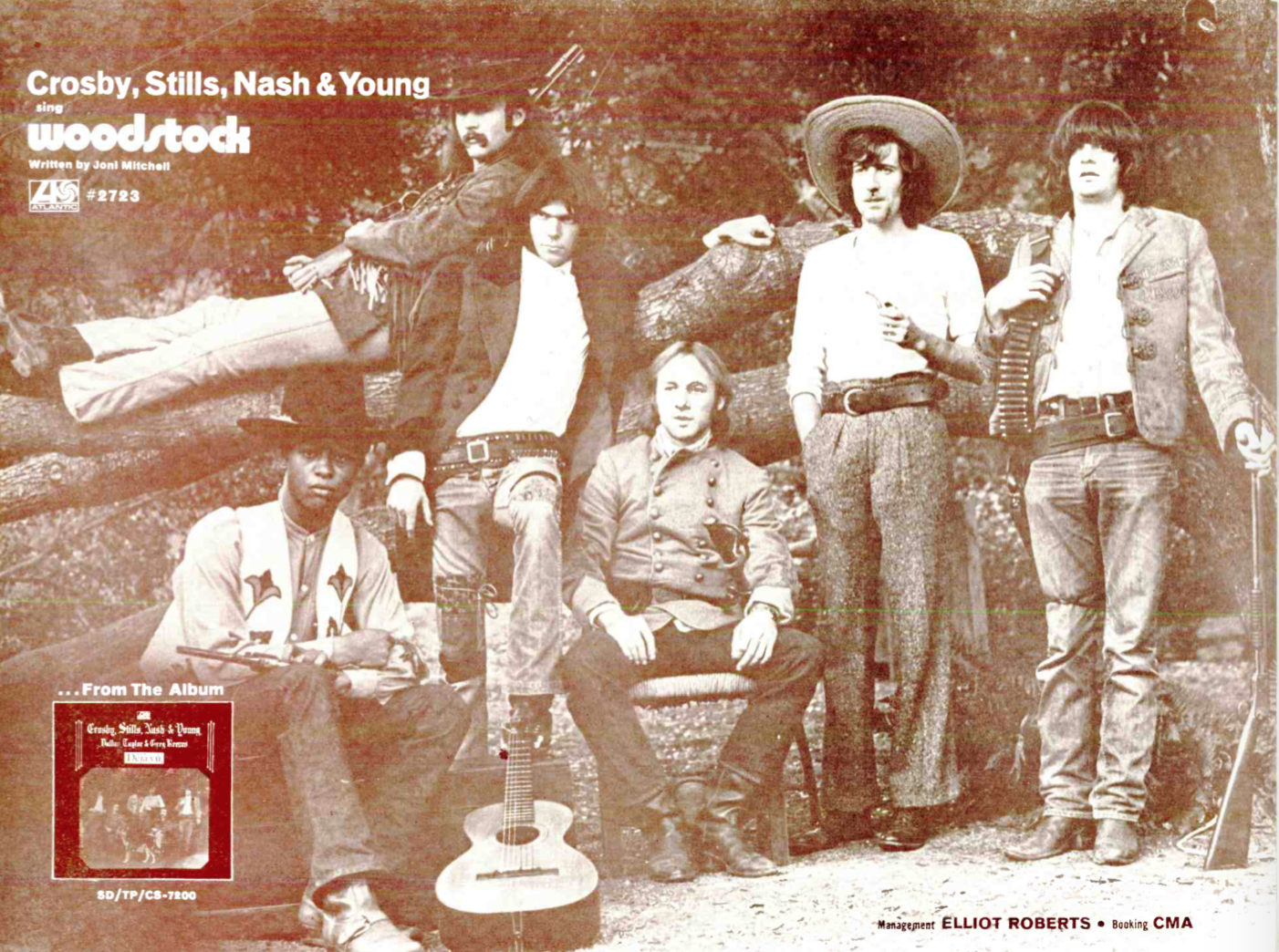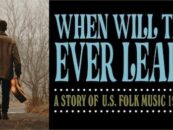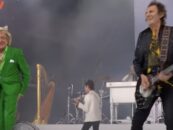Crosby, Stills, Nash & Young’s ‘Deja Vu’: A Volatile Chemistry
by Sam Sutherland
This ad for the “Woodstock” single appeared in the March 28, 1970, issue of Record World.
Even before their debut album hit stores in May 1969, David Crosby, Stephen Stills and Graham Nash faced a problem born from success. Pre-release buzz generated by their folk-rock and British Invasion pedigree via the Byrds, Buffalo Springfield and the Hollies had accelerated demand for a tour, including a headlining slot at the summer’s most anticipated live event, Woodstock. But the songs on Crosby, Stills & Nash boasted arrangements that extended well beyond the three principals’ guitars, thanks to multi-instrumentalist Stills. All three shared producer credit, but it was alpha studio rat Stills who spent hundreds of hours layering guitars, keyboards, bass and percussion beneath the tracks.
With three strong singers bringing new material into the partnership, the initial goal was to flesh out inevitable gaps onstage. Drummer Dallas Taylor had kept time on the debut’s uptempo rockers, but Stills felt they needed another musician “proficient enough [but] not as a composer or singer.” Crosby, Stills and Nash had bonded quickly through their lush vocal blend, and they envisioned a live show that would focus first on that acoustic bromance before having each member showcase solo material, then plug in for full band performances.
If Plan A involved another sideman, a surprising but provocative Plan B was advanced by Ahmet Ertegun, the Atlantic Records chief who had signed Stills in Buffalo Springfield: Ertegun suggested Neil Young, Stills’ partner in Buffalo Springfield, to fill the bill. Never mind that Young had contributed to the Springfield’s collapse through his passive-aggressive retreat to embark on a solo career. The Canadian rocker was already a proven foil for Stills, witnessed in the fiery electric guitar duels that were highlights of Buffalo Springfield’s strong live sets. Like Stills, he had flexed his chops as a one-man studio band on his self-titled debut album.
By the time they got to Woodstock, Crosby, Stills and Nash had been joined by Young, with drummer Taylor and Greg Reeves, a teenaged bassist with Motown credentials, completing the rhythm section. As planned, Crosby, Stills and Nash first took the stage for a loose but ultimately triumphant acoustic set, then returned with the full sextet to play a longer electric set. Even then, there were early signs that more than an ampersand would divide Crosby, Stills, Nash & Young in the months and years ahead.
Crosby, Stills & Nash had already cracked the top 10 on the album chart, and would go on to enjoy a 107-week run. Demand for a follow-up was only intensified by that success. Where the first album had drawn from a significant well of existing material, Crosby, Stills, Nash and Young would begin stitching together its successor from more barren cupboards, save that of the prolific Young. As before, Stills sought to dominate the sessions. This time, however, he did not have a ready centerpiece like “Suite: Judy Blue Eyes,” Crosby, Stills & Nash’s dazzling album opener and signature radio hit.
Stills’ solution was to weld a driving new song, “Carry On,” with a retooled version of “Questions,” originally cut for Buffalo Springfield’s final album. “Carry On” echoed “Suite: Judy Blues Eyes’” galloping acoustic guitars, decorated with Stills’ electric guitar filigree and underpinned by Reeves’ bass before the title chorus ascended to an apogee of lush CSN harmonies; a turnaround shifted tempo as “Questions,” newly syncopated with Latin percussion, enabled the medley to serve as “suite” spot.
Listen to “Carry On”
Related: 2 new CSN&Y biographies were published in 2019
As stunning as that track was, “Carry On” highlighted a vocal divide between the original trio and Young. Young’s thin, frail tenor couldn’t blend seamlessly with his new partners, thus confining his vocal role to solo sections on his own material. Thus, he was conspicuously absent from that track, as he would be for fully half the album’s 10 songs. Two of the album’s three singles would be Graham Nash songs framed as Crosby, Stills and Nash arrangements. “Teach Your Children” was a generational anthem that conveyed the former Hollies singer’s characteristic tenderness, warmed by the country accents of pedal steel by Jerry Garcia, whose presence reflected the band’s northward migration and the influence of Bay Area peers in Jefferson Airplane and the Grateful Dead on the erstwhile Laurel Canyon stalwarts.
Listen to the alternate mix of “Teach Your Children”
Nash’s other single contribution, “Our House,” would become an enduring favorite in large part through its association with his celebrity girlfriend: Joni Mitchell was already connected to the band through her earlier relationship with Crosby, and her subsequent affair with Nash had been documented in interviews and in song. “Our House” was Nash’s paean to the couple’s domestic bliss in Mitchell’s Laurel Canyon house.
Related: Our review of David Crosby’s free August 2019 concert in NYC
Her ties to the band would outlive the romances, especially through Déjà Vu’s most successful single. Mitchell had stayed behind in New York when Crosby, Stills, Nash and Young journeyed to Woodstock, but the band’s frontlines reports inspired her to pen a poetic account of the event. In the band’s hands, “Woodstock” became a celebratory rave-up wedding the original trio’s vocal powers with the twin guitars of Stephen Stills and Neil Young.
Listen to “Woodstock”
“Woodstock” and “Teach Your Children” weren’t the only counter-cultural signifiers on the album. Of the four members, David Crosby was still the most outspoken, a role amplified by his involvement with Northern Californian musicians, especially the Airplane. On Déjà Vu, Crosby nearly fell overboard with the more strident hippie angst of “Almost Cut My Hair,” an otherwise potent minor-keyed showcase for Stills’ and Young’s firefight on electric guitars.
Listen to the album’s title track
More successful was Crosby’s mesmerizing title song, an exercise in hushed psychedelia that showcased his velvety timbre and fluid dexterity in vocalese, as well as his ease with more sophisticated jazz harmonies in the luminous choral arrangements.
In bringing Neil Young into the fold, Crosby, Stills and Nash had solved one problem while arguably creating new ones. All four were strong-willed artists with solo aspirations, but where the others had given their alliance priority, Young’s involvement was more pragmatic. His solo career with Crazy Horse was gaining momentum even as Crosby, Stills, Nash & Young raised his profile, and on Déjà Vu he was comfortable dropping into tracks solely as an instrumental contributor. His two original songs were produced as de facto solo tracks, sonically distinct from Stills’ denser productions. The best of them, “Helpless,” shimmers with Young’s gleaming electric guitar and piano figures; Crosby, Stills and Nash provide glorious vocal backing, especially on the choruses, but the bones of the song are pure Neil Young.
Watch a 1974 live rendition of “Helpless” with Joni Mitchell joining in
By any standard, Déjà Vu, released on March 11, 1970, was a success, topping the Record World chart on April 18 [and Billboard on May 16], snaring three Top 40 single hits, and eventually moving seven million copies. Yet the alliance with Neil Young would both define and bedevil the band in the years that followed. Ultimately, his role would prove asymmetrical in a band that needed him more than he needed them, and time and again studio dates and tours for the quartet would be held hostage by his whims.
Related: A live album from the band’s 1969 performances at the Fillmore East is in the works
BONUS VIDEO: Watch Crosby, Stills, Nash and Young perform “Down by the River” on ABC Television’s The Music Scene in 1970.
Their existing catalog as a group is available in the U.S. here and in the U.K. here.







12 Comments so far
Jump into a conversationI agree somewhat with Sam Sutherland about Neil’s being a somewhat ‘rogue’ ‘in & out’ musician who would join his pal, Stephen, on recordings here and there.
The article, in some ways, however was difficult to read and understand as many of his points were too cerebral to comprehend.
As a band, CNS&Y second only to The Beatles.Every band member is able to show his own talent and allow others to show theirs, while playing a unique collective sound of their own.
God bless Neil Young.
I am pretty sure Stills played bass on Carry On not Greg Reeves
That has always been my impression too. The bass solo sounds very much like typical Stills.
I think you would have to call CSN underachievers. As for Young prolific even at times inconsistent.
Young claimed that he was/is “consistently inconsistent”
Of the four, though I have infinite respect for his talent, N Young was my least favorite. With that said, I truly love the “Country Girl Suite” contained on Deja Vu. One of my many favorites on this classic album!
CSN had to rely on Young & Stills for the songs. By 1975 it was over for CSNY as a band.
Deja Vu was one of the original titles announced in 2000 for the new DVD Audio Format. I have waited 24 years for the 5.1 version to be released and I don’t think I will ever hear (or see) it.
Neil Young was, by far, the worst thing that ever happened to CSN. They had a beautiful vocal thing going but bringing in Young, with his reedy whine and lack of commitment to the group, was a huge mistake that cannot be overstated. He almost single handedly destroyed that band, and I will never forgive him for that. And yes, I know all about the ego and the drugs and that stuff, but still… (By the way, I love Young’s progressive politics, but his music never did anything for me. I can’t stand his singing, and most of his songs are simply uninteresting.) CSN was golden and will never be matched. CSN&Y was a mess. They didn’t need Young. His personality just didn’t fit, and he couldn’t blend vocally. They just didn’t need him. Stephen Stills is ten times the musician that Neil Young will ever be.
Neil Young never grew up politically. He is still espousing BS from 1968. However, I have seen him at least 12 times, and will continue as long as he sticks to music at his shows.